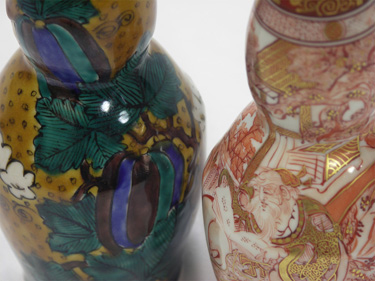|
The story of Kutani Porcelain
yThe origin of the five spectacular kutani colorsz
At the upper reaches of the Daishoji River,deep in the mountains, there was once a village called Kutani.
A stone monument bearing the inscription "Ko-Kutani kiln ruins" stands quietly in a clearing.
It marks the spot where the Daishoji Clan(a branch of Kaga Clan) established a kiln in about 1655, to make use of local porcelain stone.
The porcelain ware that was created there was later called "Ko-Kutani", and become the foundation for Japanese colored porcelain ware.
Rich overglaze colors applied with fluid brushwork - green, yellow, red, purple and blue - give Kutani porcelain its characteristic beauty.
However, only half a century later the kiln was abandoned for reasons that nobody knows.
About 100 year later, Kutani porcelain was revived under the patronage of the Kaga clan.
The Kasugayama and Wakasugi kilns were established, and kilns such as the Yoshidaya kiln rode one the momentum of "revived Kutani", all producing overglaze porcelain ware.
Various styles competed and combined to develop into the overglaze techniques that have been handed down to this day.
In modern times, the gorgeous Kinrande style has become well known in the West as "Japan Kutani".
Kutani porcelain, which combines the artistry of Ko-Kutani ware and the utilitarian beauty that developed from "revived Kutani", Continues to evolve.
yA traditional craft promoted by the wealth Kaga clanz
In the Edo period, the Maeda family governed the prosperous fiefdom of Kaga.
Successive Kaga lords, who were well-versed in culture and the performing arts, promoted a policy of civilian government, making their fiefdom a center for crafts, especially Kutani porcelain.
What made the luxury possible were the local geographical features - Mt. Hakusan, the Kaga Plain and the Japan Sea, as well as an abundance of food.
In Ishikawa, a prefecture with a tradition of outstanding craftsmanship, Japan-style beauty is still alive and well.
Text by
Ishikawa Kutani Hall & Ishikawa Kutani Porcelain Cooperative Union
|
|



|
|